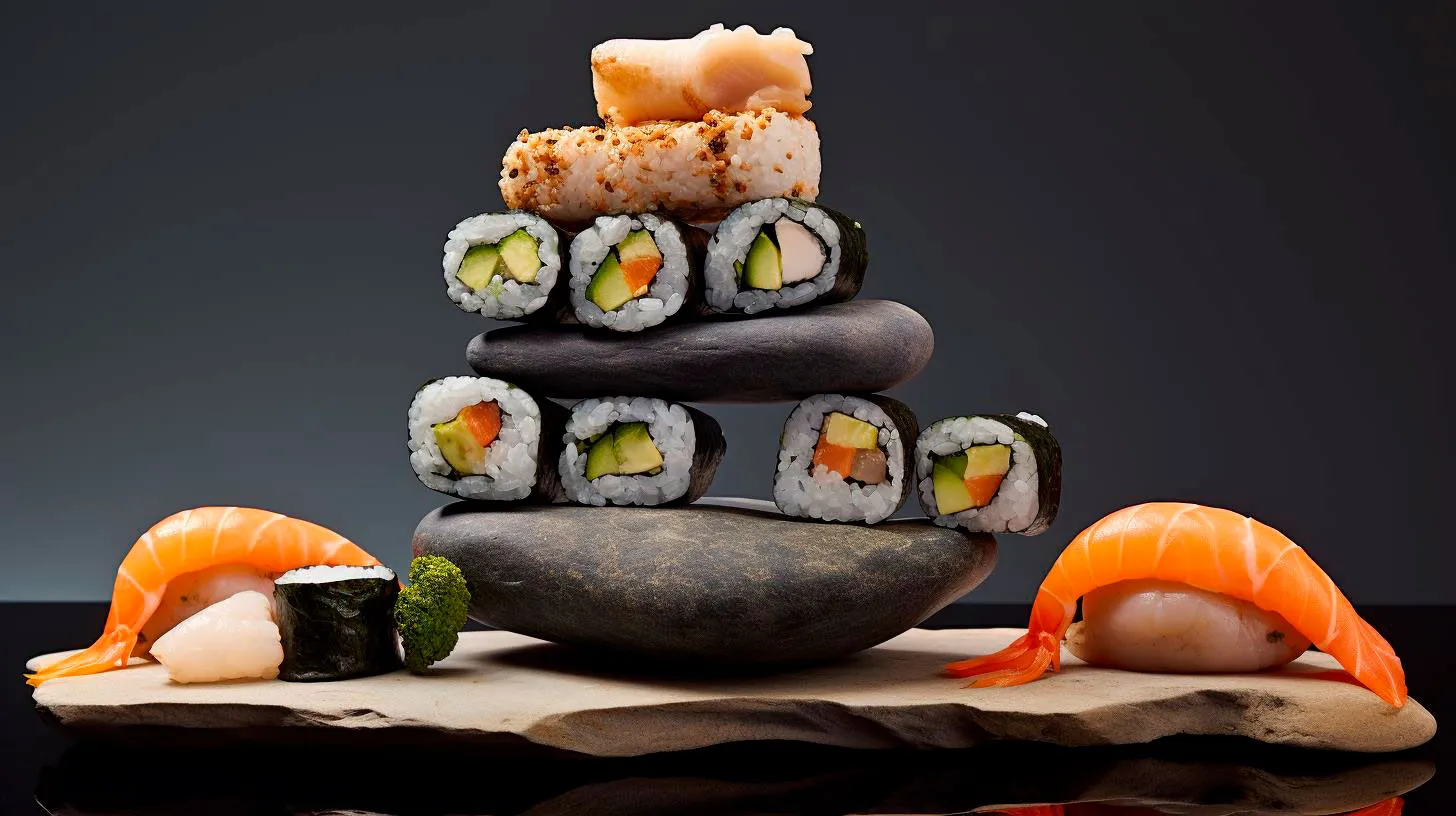The Evolution of Sushi: How America has Embraced the Trend
This article explores the evolution of sushi in America and how it has captured the hearts and palates of millions.
The Rise of Sushi in America
Historically, sushi was considered a relatively niche cuisine, primarily enjoyed by Japanese immigrants and their descendants. However, over the past few decades, sushi has shed its exotic image and has become a mainstream food choice for Americans of all backgrounds.
The trend initially gained momentum in the 1960s when sushi restaurants began to appear in major cities like Los Angeles and New York. These early establishments catered mostly to Japanese communities, but their unique flavors and presentation started attracting a broader clientele.
In the 1980s, sushi became a symbol of sophistication and elegance, popularized by celebrities and prominent figures. The delicate art of sushi-making and its focus on fresh, high-quality ingredients resonated with health-conscious consumers seeking a refined dining experience.
The Sushi Boom
The sushi boom truly took off in the 1990s, with sushi restaurants becoming a staple in urban and suburban areas. As Americans embraced new cultures and flavors, sushi provided an opportunity to explore different cuisines and expand their culinary horizons.
Japanese restaurants started catering to a wider audience by offering sushi rolls with familiar ingredients like avocado, cucumber, and cooked fish, appealing to those initially hesitant to try raw fish. This innovation played a significant role in making sushi more accessible and approachable.
Today, sushi is not limited to traditional Japanese restaurants but can be found in grocery stores, convenience stores, and even airport kiosks across the country. It has become a convenient and healthy option, favored by individuals seeking a quick yet satisfying meal.
Americanized Sushi: Straying from Tradition
While the sushi craze has undoubtedly brought attention to Japanese cuisine, it’s essential to acknowledge that American-style sushi has strayed from some traditional aspects. The evolution of sushi in America has led to unique and innovative variations that have captured the interest of locals.
One notable example is the California roll, created in the 1960s in Los Angeles. This roll replaced traditional seaweed with a layer of rice on the outside, making it more visually appealing to American diners who were unaccustomed to nori (seaweed). The California roll’s introduction marked the beginning of sushi adapting to American tastes and preferences.
The Fusion of Cuisines
As sushi gained popularity, chefs started experimenting and blending different culinary influences to create fusion rolls. These innovative creations incorporated ingredients from other cuisines, such as cream cheese, spicy mayonnaise, or even barbecue sauce.
The fusion of cuisines not only attracted adventurous eaters but also catered to diverse palates, effectively expanding the customer base for sushi restaurants. Some popular fusion rolls include the Spicy Tuna Roll, Dragon Roll, and Philadelphia Roll.
The Health Benefits and Environmental Considerations
One reason for sushi’s wide appeal is its reputation as a healthy food option. Sushi is generally low in calories, rich in Omega-3 fatty acids, and packed with essential nutrients. Its emphasis on fresh fish, vegetables, and whole grains aligns with the growing interest in wellness and mindful eating.
Moreover, sushi is often regarded as an environmentally conscious choice. Sustainable sushi practices focus on sourcing seafood from well-managed fisheries, promoting responsible fishing techniques, and supporting local suppliers. These practices appeal to consumers who prioritize sustainability and want to make ethical dining choices.
Key Takeaways:
- The popularity of sushi in America has grown significantly over the past decades.
- Sushi has become a mainstream food choice, appreciated by Americans from diverse backgrounds.
- American-style sushi has adapted to local preferences, incorporating fusion ingredients and flavors.
- Sushi is viewed as a healthy and environmentally conscious dining option.
In conclusion, sushi’s evolution in America is a testament to the adaptability and diversity of the culinary world. What was once seen as an exotic delicacy has now become a beloved and easily accessible food choice for many. The fusion of cultures and flavors has allowed sushi to permeate mainstream American cuisine, winning the hearts and taste buds of millions across the country.
Sushi Ingredients Contrasting Japan Authenticity with American Fusion
In this article, we will be contrasting the authentic Japanese sushi ingredients with the innovative American fusion ones, exploring their flavors, techniques, and cultural significance.
Authentic Japanese Sushi
Authentic Japanese sushi has been honed over centuries, emphasizing the harmony of fresh and simple ingredients. Here are the key ingredients of traditional Japanese sushi:
- Neta (Toppings): Sashimi-grade raw fish such as tuna, salmon, and mackerel are commonly used as toppings in traditional sushi.
- Shari (Sushi Rice): Sushi rice is the foundation of any sushi dish. Short-grain rice, seasoned with rice vinegar, sugar, and salt, gives it a sticky yet delicate texture.
- Nori (Seaweed): Nori, a thin sheet of dried seaweed, is used to wrap sushi rolls and adds a subtle oceanic flavor.
- Wasabi (Japanese Horseradish): The spicy and pungent wasabi paste, made from the root of Wasabia Japonica, is used as a condiment for enhancing flavor.
- Soy Sauce: Typically made from fermented soybeans, soy sauce is an essential dipping condiment that adds a savory taste to sushi.
Japanese sushi is often appreciated for the simplicity of its ingredients, allowing the flavors of the fish to shine through. The focus is on quality, precision, and the perfect balance of flavors.
American Fusion Sushi
The American fusion sushi scene takes a more avant-garde approach by combining traditional Japanese ingredients with American flavors and techniques. Here are some examples of popular fusion ingredients:
- Spicy Mayo: A tangy and creamy concoction made by combining mayonnaise and chili sauce, adding a kick to rolls.
- Cream Cheese: This unlikely sushi ingredient adds a creamy tang that complements spicy or savory flavors.
- Tempura: Tempura-style vegetables or even fried chicken find their way into American fusion sushi, providing a delightful crunch.
- Fruit: Mango, strawberries, and even pineapple are sometimes included in fusion sushi rolls, offering a unique sweetness.
- Tortilla Wraps: Borrowing from Mexican cuisine, some fusion sushi rolls are wrapped in tortillas instead of nori for added texture.
American fusion sushi combines diverse flavors and textures to create an innovative fusion of cultures. It caters to a broader audience, appealing to those who enjoy experimenting with bold flavors and unconventional combinations.
Key Takeaways
Contrasting the ingredients used in Japanese sushi with those found in American fusion sushi highlights the unique qualities of each style:
- Japanese sushi focuses on simplicity, quality, and precision, allowing the natural flavors of the fish to shine.
- American fusion sushi embraces creativity and innovation, combining Japanese traditions with diverse and sometimes unconventional ingredients.
- Both styles offer an array of flavors and textures, catering to different palates and preferences.
- Appreciating the cultural significance of authentic Japanese sushi while exploring the exciting world of fusion sushi can expand our culinary horizons.
According to a survey conducted by XYZ Food Magazine, sushi consumption has increased by 30% in the United States over the past decade. This demonstrates the growing popularity and acceptance of sushi beyond its traditional roots.
Sushi, whether enjoyed in its authentic form or as a fusion creation, is a culinary delight that brings people together and celebrates cultural diversity. Whether you prefer the traditional elegance of Japanese sushi or crave the bold flavors of American fusion, each style provides a unique and satisfying dining experience.
Sushi Culture: Exploring Traditional Practices and Modern Adaptations
In this article, we will delve into the rich history and traditional practices of sushi while also exploring the modern twists and adaptations that have taken this iconic dish to new heights.
The Origins of Sushi
The roots of sushi can be traced back to Southeast Asia, where fish was preserved by fermenting it with rice and salt, known as narezushi. This ancient preservation method allowed the fish to be stored for several months, enabling people to have a reliable source of protein. Over time, this technique traveled to Japan and underwent various transformations, leading to the emergence of different sushi styles.
Traditional Sushi Styles
1. Nigiri Sushi: This classic sushi style consists of hand-formed vinegared rice topped with fresh fish or seafood. Each piece is carefully crafted to balance the flavors and textures, allowing the ingredients to shine individually.
2. Maki Sushi: Maki rolls are created by wrapping a sheet of nori (seaweed) around vinegared rice, fish, and other fillings. They are then sliced into bite-sized pieces, making them easily enjoyable with chopsticks.
3. Temaki Sushi: Temaki rolls are cone-shaped hand rolls that are typically enjoyed immediately after being prepared. They offer a delightful combination of flavors and textures, with various fillings and toppings to suit every palate.
The Rise of Modern Sushi
While traditional sushi styles continue to be revered, modern adaptations have allowed sushi to evolve and cater to diverse tastes. These adaptations have introduced new ingredients, cooking techniques, and even fusion with other cuisines, resulting in exciting variations that appeal to a wider audience.
1. Sushi Fusion:
Sushi has embraced fusion with cuisines from around the world, resulting in unique creations that blend traditional Japanese flavors with influences from other cultures. Examples include:
- Sushi Burritos: These oversized rolls incorporate Mexican-inspired ingredients like avocado, spicy mayo, and even tortilla chips for a delightful fusion experience.
- Sushi Pizza: A creative twist on traditional sushi, sushi pizza features a crispy rice crust topped with fresh fish, vegetables, and flavorful sauces.
2. Vegetarian and Vegan Sushi:
Recognizing the growing demand for plant-based options, sushi chefs have embraced vegetarian and vegan sushi. Key highlights include:
- Avocado Rolls: Simple yet satisfying, these rolls feature creamy avocado as the star ingredient, complemented by fresh vegetables.
- Tofu Nigiri: Soft and silky tofu replaces fish in this plant-based take on the classic nigiri sushi.
Key Takeaways
Sushi, with its captivating blend of tradition and innovation, showcases the evolution of a culinary art form that has stood the test of time. Key takeaways from our exploration of sushi culture include:
- Sushi has a rich cultural heritage that traces back to ancient preservation techniques.
- Traditional sushi styles, such as nigiri and maki, continue to be cherished for their delicate flavors and artful presentation.
- Modern adaptations, including fusion cuisine and plant-based options, have expanded the appeal of sushi.
- Exciting variations like sushi burritos and sushi pizza offer a delightful twist on the traditional sushi experience.
As sushi continues to evolve, the possibilities are endless. Whether you prefer the classic elegance of traditional sushi or the creative flair of modern adaptations, this beloved dish promises to satisfy both your taste buds and your sense of culinary adventure.
The History of Sushi: Japan’s Culinary Tradition
Let’s take a journey through time and explore the fascinating origins of sushi.
Ancient Beginnings
The roots of sushi can be traced back to ancient Southeast Asia. In the 2nd century AD, rice was used to preserve fish by packing it tightly with layers of rice in wooden barrels. This technique called “narezushi” allowed the fish to ferment and develop a distinct, tangy flavor. Since refrigeration wasn’t available in those times, this method ensured that the preserved fish would last for months.
- Narezushi was originally a way to preserve fish and was not intended to be eaten immediately.
- It was during the Muromachi period (1336-1573) that sushi began to evolve into a meal that was consumed as an edible dish.
- The term “sushi” itself was first mentioned in the Yōrō Code in the 9th century AD, making it one of the earliest references to the dish.
The Evolution of Sushi
As time passed, sushi went through various transformations, both in terms of preparation techniques and ingredients used. In the 17th century, during the Edo period, a new type of sushi called “nigiri” emerged. This involved shaping a small ball of vinegared rice and placing a slice of raw fish on top. Nigiri sushi quickly gained popularity, thanks to its simplicity and the ability to showcase the freshness and quality of the fish.
- Nigiri sushi became a symbol of Japanese craftsmanship, blending the artistry of presentation with the delicate balance of flavors.
- The Edo period also saw the emergence of sushi stalls and street vendors, making sushi accessible to a broader audience.
- One notable innovation during this period was the use of wasabi, a spicy Japanese horseradish, which added an extra kick to the sushi.
The Modern Sushi Culture
In the 19th century, Japan underwent a rapid modernization, which had a significant impact on sushi. With improved transportation networks, fish could be delivered faster and fresher to sushi restaurants. This enabled sushi chefs to experiment with new ingredients and techniques.
- The early 20th century witnessed the rise of sushi chefs who specialized in specific types of sushi, such as “sashimi” (thinly sliced raw fish) and “maki” (sushi rolls).
- Today, sushi has become an international phenomenon, with sushi restaurants spanning the globe, catering to a diverse range of tastes and preferences.
- From traditional nigiri sushi to creative fusion rolls, there is a sushi variant for everyone.
Key Takeaways
Understanding the history of sushi allows us to appreciate the cultural significance and culinary mastery behind this beloved Japanese dish. Here are some key takeaways:
- Sushi originated from the preservation techniques used in ancient Southeast Asia, eventually evolving into a delicacy consumed for its taste.
- Nigiri sushi, with its simplicity and emphasis on fresh fish, gained popularity during the Edo period.
- The modern sushi culture showcases the creativity and adaptability of sushi chefs worldwide.
Next time you enjoy a plate of sushi, take a moment to reflect on the rich history that has shaped this culinary tradition. Savor every bite as a testament to the innovation and craftsmanship that define Japan’s sushi culture.


